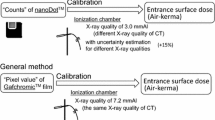Abstract
We aimed to evaluate properties of optically stimulated luminescence dosimeters (OSLDs) and radiophotoluminescent glass dosimeters (RPLDs) used in dual-source dual-energy (DE) computed tomography (DECT) dosimetry. Energy dependence was evaluated in single-energy (SE) and DE modes, and their relative dose responses differed by 3.8% and 6.6% under equivalent effective energy with OSLD and RPLD, respectively. Dose variation was evaluated using coefficients of variation of dose values from 10 dosimeters, and dose variation of OSLD and RPLD in SE mode ranged from 2.1 to 3.0% and from 2.1 to 2.8%, and those in the DE mode were 1.8 and 2.6%, respectively. Dose linearity was evaluated from 1 to 150 mGy, and linear relationships of dose response were observed between the dosimeters and the ionization chamber (correlation coefficients ≥ 0.9991). Angular dependence was evaluated from − 90° to + 90°, and it was smaller in DE mode than in SE mode for OSLD. The normalized response of RPLD was higher at ± 30° and ± 60° and lower at − 90° in SE and DE modes. This study demonstrated both OSLD and RPLD can perform dosimetry in dual-source DECT with small influence of the properties of the dosimeters compared with that in SECT.






Similar content being viewed by others
References
Regulla DF, Eder H (2005) Patient exposure in medical X-ray imaging in Europe. Radiat Prot Dosim 114:11–25
Kang MJ, Park CM, Lee CH et al (2010) Dual-energy CT: clinical applications in various pulmonary diseases. Radiographics 30:685–698
Lee KYG, Cheng HMJ, Chu CWA et al (2019) Metal artifact reduction by monoenergetic extrapolation of dual-energy CT in patients with metallic implants. J Orthop Surg 27:1–7
Long Z, Bruesewitz MR, DeLone DR et al (2018) Evaluation of projection- and dual-energy-based methods for metal artifact reduction in CT using a phantom study. J Appl Clin Med Phys 19:252–260
International Commission of Radiological Protection (2000) Managing patient dose in computed tomography. Ann ICRP 30:7–45
Giansante L, Martins JC, Nersissian DY et al (2019) Organ doses evaluation for chest computed tomography procedures with TL dosimeters: comparison with Monte Carlo simulations. J Appl Med Phys 20:308–320
Moore WH, Bonvento M, Olivieri-Fitt R (2006) Comparison of MDCT radiation dose: a phantom study. AJR Am J Roentgenol 187:498–502
Diekmann S, Siebert E, Juran E et al (2010) Dose exposure of patients undergoing comprehensive stroke imaging by multidetector-row CT: comparison of 320-detector row and 64-detector row CT scanners. AJRNR Am Neuroradiol 31:1003–1009
Zhang D, Li X, Gao Y et al (2013) A method to acquire CT organ dose map using OSL dosimeters and ATOM anthropomorphic phantoms. Med Phys 40:081918
Paul AJ (2007) Characterization of optically stimulated luminescent dosimeters, OSLDs, for clinical dosimetric measurements. Med Phys 34:4594–4604
Kadoya N, Shimomura K, Kitou S et al (2012) Dosimetric properties of radiophotoluminescent glass detector in low-energy photon beams. Med Phys 39:5910–5916
Scarboro SB, Cody D, Alvarez P et al (2015) Characterization of the nanodot OSLD dosimeter in CT. Med Phys 42:1797–1807
Yusuf M, Saoudi A, Alothmany N et al (2014) Characterization of the optically stimulated luminescence nanoDot for CT dosimetry. Life Sci J 11:445–450
Hirosawa A, Matsubara K, Kondo H et al (2015) Properties and usage of radiophotoluminescent glass dosimeters for computed tomography dosimetry. Nihon Hoshasen Gijutsu Gakkai Zasshi 71:12–18 (in Japanese)
Scarboro SB, Kry SF (2012) Characterisation of energy response of Al2O3: C optically stimulated luminescent dosimeters (OSLDs) using cavity theory. Radiat Prot Dosim 153:23–31
Hill R, Mo Z, Haque M et al (2009) An evaluation chambers for the relative dosimetry of kilovoltage X-ray beams. Phys Med 36:3971–3981
Yahnke C (2009) Calibrating the microStar. Landauer, Glenwood
International Organization for Standization (2008) Guide to the expression of uncertainties in measurement. ISO 98–3
Matsubara K, Ichikawa K, Murasaki Y et al (2014) Accuracy of measuring half- and quarter- value layers and appropriate aperture width of a convenient method using a lead-covered case in X-ray computed tomography. J Appl Clin Med Phys 15:309–316
Seltzer SM, Hubbell JH (1996) Tables and graphs of photon mass attenuation coefficients and mass energy-absorption coefficients for photon energies 1 keV to 20 MeV for elements Z=1 to 92. The X-ray Attenuation and Absorption for Materials of Dosimetric Interest Database. NIST. https://doi.org/10.18434/T4D01F
Al-Senan RM, Hatab MR (2011) Characteristics of an OSLD in the diagnostic energy range. Med Phys 38:4396–4405
Kato H, Hayashi N, Suzuki S et al (2011) Problem of the effective energy used as a quality expression of diagnostic X-ray. Nihon Hoshasen Gijutsu Gakkai Zasshi 67:1320–1326
Carvalho Junior AB, Barros TF, Guzzo PL et al (2012) Manufacturing polycrystalline pellets of natural quartz for applications in thermoluminescence dosimetry. Mater Res 15:536–543
Hsu SM, Lai YC, Jeng CC et al (2017) Dosimetric comparison of different treatment modalities for stereotactic radiotherapy. Radiat Oncol 12:155
Sato F, Zush N, Nagai T et al (2013) Development of radiophotoluminescence glass dosimeter usable in high temperature environment. Radiat Meas 53–54:8–11
Manninen AL, Koivula A, Nieminen MT (2012) The applicability of radiophotoluminescence dosimeter (RPLD) for measuring medical radiation (MR) doses. Radiat Prot Dosim 151:1–9
Acknowledgements
We would like to express our gratitude to Mr. Hiroshi Takamatsu of Siemens Healthineers Japan and Mr. Yasuhiro Hirano of Marubun Tsusho, who provided technical assistance with the experiments.
Funding
This work was supported by JSPS KAKENHI Grant Number JP18K07746.
Author information
Authors and Affiliations
Corresponding author
Ethics declarations
Conflict of interest
The authors declare no conflicts of interest exist.
Ethical approval
Not applicable. This article does not contain any studies with human participants or animals performed by any of the authors.
Additional information
Publisher's Note
Springer Nature remains neutral with regard to jurisdictional claims in published maps and institutional affiliations.
Rights and permissions
About this article
Cite this article
Hirosawa, A., Matsubara, K., Morioka, Y. et al. Use of optically stimulated luminescence dosimeter and radiophotoliminescent glass dosimeter for dose measurement in dual-source dual-energy computed tomography. Phys Eng Sci Med 44, 1311–1319 (2021). https://doi.org/10.1007/s13246-021-01063-6
Received:
Accepted:
Published:
Issue Date:
DOI: https://doi.org/10.1007/s13246-021-01063-6




